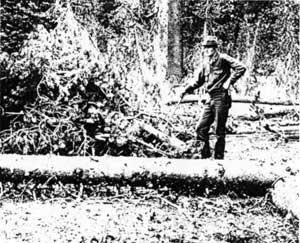The Battle Against Bark Beetles in Crater Lake National Park: 1925-34
Events From 1930-31
|
|
This brings us to the pivotal years of the war that had been waged since 1925. Keen, in December 1930, made a detailed report of the 1930 control operations. Before June 11 the work was confined to recleaning units treated in 1929. The work continued until July 8 on the middle fork-east fork plateau in heavy infestations. A total of 9,832 trees were treated, but 1,897 trees could not be treated before the beetles emerged (see footnote 1). F.C. Craighead, Chief of Forest Insect Investigations, Bureau of Entomology, came from Washington, DC, on July 21 to visit the outbreak with Keen. They found an additional 115 whitebark pine(Pinus albicaulis Engelm.) and lodgepole pine at high elevations that still contained brood, so these trees were also treated to bring the total for the season to 9,947 trees (see footnote 1). Keen pointed out that lodgepole pine between 75 and 150 years old are very susceptible to the beetle. The estimates for the coming year were that there would be a total of 10,000 trees to treat. “The completion of this work should leave the lodgepole stands in very good shape except for an endemic infestation which should be watched for a few years and controlled if it develops active characteristics” (see footnote 1). An optimistic view in light of 10,000 trees needing treatment in 1931.
In October 1930, Keen wrote a letter to Craighead in Washington, DC, in which he outlined his control recommendations for 1931 before he completed his formal report. Keen for the first time advocated “…treating all of the epidemic infestation in the south half of the Park which I now feel is the wisest policy since the general situation has improved so materially in the past few seasons.” [21] A strange statement in view of the continued rise in number of trees needing treatment since 1927. Keen also hoped the Park Service could allot $10,000 for the suppression work in 1931; a tidy sum in 1930 dollars (see footnote 1).
On October 21, Craighead replied, “Your plan for control work on the Crater [Crater Lake National Park], proposed in your letter of October 12, appears entirely satisfactory to me” (see footnote 21). Craighead went on to recommend “…that every effort be concentrated on the heavier groups of infestation and the outlying, more or less endemic type be left until last or allowed to go until another year” (see footnote 21). He felt there was enough experience to show that scattered infestation would not be an immediate threat. Patterson also replied to a letter from Keen, that is missing from the files, about some control unit designations. In the letter [22] was this sad paragraph,
Godfrey’s death was certainly a blow to all who knew him. Coming so unexpectedly as it did, I was particularly shocked. He was a dandy fellow and a prince to work with. His habit of hiking off alone on any and all wild goose chases finally got him. He did the same thing when we were in the Park together in 1929. Always out alone with a mightly poor constitution to carry him thru. Both he, Patton, and several others caved-in the day we moved into the Park from the west entrance. Without a knowledge of snow and the individuals possibilities in bucking it, it is a real danger. Solinsky and I made the same kind of trip that Bill attempted, leaving Ft. Klamath at 7:30PM we arrived at Anna Spring at 1:30AM. I never attempted it again.
The following newspaper account of William Godfrey’s misadventure and death was found in the Crater Lake headquarters files. [23]


